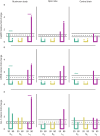Parallel mechanisms of visual memory formation across distinct regions of the honey bee brain
- PMID: 34515309
- PMCID: PMC10659034
- DOI: 10.1242/jeb.242292
Parallel mechanisms of visual memory formation across distinct regions of the honey bee brain
Abstract
Visual learning is vital to the behavioral ecology of the Western honey bee (Apis mellifera). Honey bee workers forage for floral resources, a behavior that requires the learning and long-term memory of visual landmarks, but how these memories are mapped to the brain remains poorly understood. To address this gap in our understanding, we collected bees that successfully learned visual associations in a conditioned aversion paradigm and compared gene expression correlates of memory formation in the mushroom bodies, a higher-order sensory integration center classically thought to contribute to learning, as well as the optic lobes, the primary visual neuropil responsible for sensory transduction of visual information. We quantified expression of CREB and CaMKII, two classical genetic markers of learning, and fen-1, a gene specifically associated with punishment learning in vertebrates. As expected, we found substantial involvement of the mushroom bodies for all three markers but additionally report the involvement of the optic lobes across a similar time course. Our findings imply the molecular involvement of a sensory neuropil during visual associative learning parallel to a higher-order brain region, furthering our understanding of how a tiny brain processes environmental signals.
Keywords: Apis mellifera; Aversive learning; Mushroom bodies.
© 2021. Published by The Company of Biologists Ltd.
Conflict of interest statement
Competing interests The authors declare no competing or financial interests.
Figures

References
-
- Adachi, S., Kawamura, K. and Takemoto, K. (1993). Oxidative damage of nuclear DNA in liver of rats exposed to psychological stress. Cancer Res. 53, 4153-4155. - PubMed
Publication types
MeSH terms
Grants and funding
LinkOut - more resources
Full Text Sources
Medical
Research Materials
Miscellaneous

